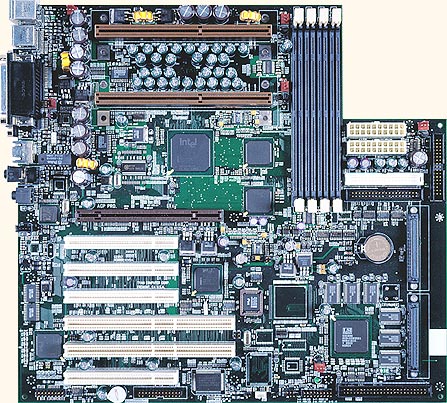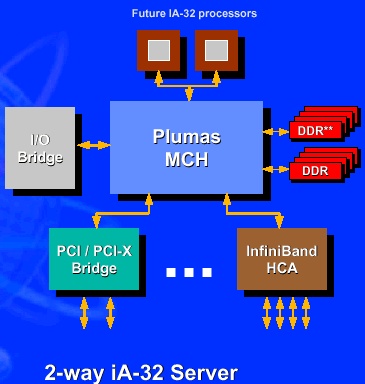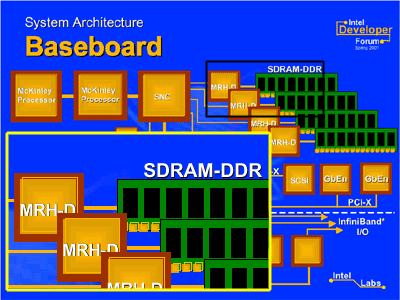Intel Developer Forum Conference - Spring 2001: Part 1
by Anand Lal Shimpi on March 5, 2001 12:00 PM EST- Posted in
- Trade Shows
Run for your lives: MTH returns
When the i820 chipset was released, OEMs had such a hard time pushing the chipset because of the incredible cost of RDRAM (very close to $1000 for a 128MB stick). Intel's quick and dirty fix was to introduce a chip called the Memory Translator Hub that sat between the i820's Memory Controller Hub (MCH) and the memory banks that would translate the 16-bit, 400MHz RDRAM signal into a 64-bit, 133MHz PC133 SDRAM signal. The same translation would occur on the way back from the memory to the MCH.

As you can guess, this resulted in a huge performance hit. The drop was anywhere between 10 - 20% when compared to regular PC800 RDRAM without the MTH.

On the i840, because of its dual channel RDRAM design, Intel developed another chip called the SDRAM Memory Repeater Hub (MRH-S) that performed the same function as the MTH did on the 820 except it worked with the dual channel memory bus of the 840's MCH. Both the MTH and MRH-S were recalled because of reliability issues, much like those we experienced with Tyan's short-lived MRH-S based Thunder 2400 board.
Something caught our eyes when we were looking at an McKinley presentation at IDF. Since the McKinley will be a server class product it falls under Intel's blanket statement that DDR SDRAM is only for servers. The McKinley will be using the i870 chipset, and below is the block diagram that raised our eyebrows:
We've taken the liberty of blowing up the section that we're interested in, see the MRH-D chips that lie between the i870 chipset and the DDR SDRAM banks? That is a DDR SDRAM Memory Repeater Hub, which sounds a lot like the MRH-S that was made for the i840 that happened to be a variant of the MTH that we all loved to hate.
This could be a huge performance penalty for McKinley as we noticed when we paired up regular SDRAM and the MTH enabled i820 or the MRH-S enabled i840.
The even bigger question is why would Intel release a McKinley chipset without a native DDR SDRAM controller? Maybe Intel is planning on bringing RDRAM to the server markets as well? It would make sense since it would be fairly easy to simply remove the MRH-D and replace the DDR SDRAM slots with RDRAM banks.
Keep your eyes on this one; it will be very interesting to see what Intel does here, very interesting indeed.
We did make sure that the future DDR platforms for the desktop market would in fact be true DDR solutions and wouldn't use a MRH-D controller; luckily we did get confirmation of this. As you can see by the below block diagram of an upcoming desktop chipset codenamed "Plumas" it has an integrated DDR SDRAM controller.

From the block diagram it also looks like this particular chipset has a dual channel DDR controller, however that could also be an artistic element of the drawing.
We've just scratched the surface…
There is so much more to report on, we've really just scratched the surface with this first article. InfiniBand, PCI-X, Intel's extreme hatred for Transmeta, the future of desktop LCD and notebook markets, AMD's future, ATI vs NVIDIA in the 3D graphics market and the list goes on.
Keep checking back for the latest on the updates from the industry. Until then here are some other articles you may find of interest that relate to the material discussed in this piece:
Weekly Memory & Motherboard Price Guide
ServerWorks HEsl: DDR bandwidth without DDR SDRAM











2 Comments
View All Comments